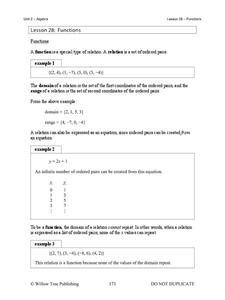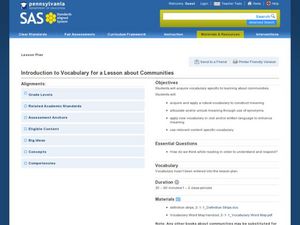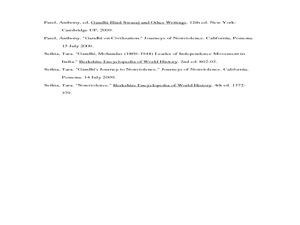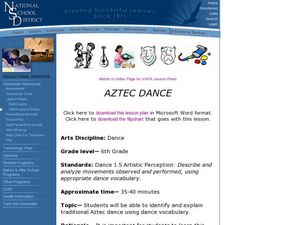Curated OER
Taking a picture Walk
First graders use question words to answer comprehension questions. In this reading strategies instructional activity, 1st graders use picture cues and predict events in a story. Students use context clues to understand unfamiliar...
Curated OER
Christmas Tree Shaped Poems
Learners think about ways in which they can spread joy during the holiday season. They create poems in the shape of a Christmas tree. Pupils use formatting tools in Microsoft Word to format the text of the poem. Students discuss ways...
Novelinks
Where the Red Fern Grows: Question Answer Response Strategy
What makes a good question? Middle schoolers explore the use of questioning through QAR, the question answer response strategy, while reading Where the Red Fern Grows. They learn about the four types of questions: right there, think and...
Curated OER
“THE LORAX” by Dr. Seuss
Few children's books convey the message of conservation as well as Dr. Seuss' The Lorax. Read the story aloud, emphasizing the interconnectedness of plants and animals in an ecosystem and discussing different ways people can help the...
Willow Tree
Functions
What makes a function a function? Learn the criteria for a relation defined as a function both numerically and graphically. Once young mathematicians define a function, they use function notation to evaluate it.
Curated OER
Using A Dictionary
Students explore English by completing a word definitions worksheet. In this dictionary lesson plan, students practice locating a list of vocabulary terms in a "Dictionary Race." Students complete a worksheet based upon word cards and...
Curated OER
Introducation to Vocabulary for a Lesson about Communities
Students practice using new vocabulary they learn about communities. In this communities vocabulary lesson plan, students use synonyms, context clues, and relevant content to unlock the meaning of new vocabulary words.
Curated OER
Down the Knoll Without the Water
Students use a thesaurus to find synonyms for selected words in fairy tales.
Curated OER
What's Holding Up the Water?
Learners read about the history and locate dams in Arizona. In this Arizona dams lesson plan, students write a summary about what they read focusing on word choice, ideas, conventions, and geography content.
Curated OER
Arithmetic: Place Value
Pupils explore the mathematical concept of place value. In this mathematics lesson, students use a question and answer format. The instructor clarifies the answers and possible mistakes as discussion takes place.
Curated OER
The Diary of Anne Frank
Eighth graders read the Diary of Anne Frank. In this novel reading instructional activity, 8th graders read and analyze the story. Students do online activities and create a newspaper giving a summary of three major events in the story....
Curated OER
Reading-Context Clues Expert
Fifth graders understand what the definition is for context clues as the words, phrases, and sentences around the word one does not know. In this language arts lesson, 5th graders review the different kinds of context clues. Students...
Curated OER
Fall Similes and Metaphors
Young scholars interpret what a similies and metaphors are. They give examples of similies and metaphors. Pupils write different similies and metaphors using fall or autumn descriptive words. Students base their comparisons on facts,...
Curated OER
Nonviolence and Conflict: Its Importance to Building Community
Students study nonviolence and the values associated with nonviolence. In this social science lesson, students identify the six steps of nonviolence and the six principles of nonviolence as put forth by Martin Luther King, Jr. Students...
Curated OER
Reading About the Journey: The Odyssey
Young scholars practice their reading skills. In this reading fluency and comprehension lesson, students read instructor-selected passages from The Odyssey following the provided steps for the reading class activity that requires them to...
Curated OER
Spelling: Homophone Review
Third graders practice using homophones. In this homophones lesson, 3rd graders review what makes a word a homophone and use clues to complete a worksheet that requires them to write in the correct homophone.
Curated OER
Sounding out fluency, Relay Race
Learners practice reading. In this fluency building lesson plan, students participate in a relay race to quickly sound and read word cards. They work in small groups to accurately sound out and say three word cards before it is another...
Curated OER
Whose Voice Do I Hear?
Fifth graders examine the power of voice in writing by completing a story using words following a particular voice. They take simple nursery rhymes, then attempt to put their own voice to a revised version. An interesting lesson on writing!
Curated OER
Gearing up for Grammar
Students input autobiographical information to apply in a Diamante' poem that utilizes the different parts of speech. Students interact with each other sharing their autobiographical information completed on the database created....
Curated OER
Exponents
Sixth graders explore mathematics by participating in a SMART Board activity. In this exponents lesson plan, 6th graders identify the different exponential powers of a number and discuss how the power of the number accumulates. Students...
Curated OER
Aztec Dance
Seventh graders study Aztec dance to learn about their culture and civilization. In this Aztec study lesson, 7th graders watch a video of Aztec dancers and describe the dance on an index card. Students visit a website to learn the...
Curated OER
How Sharp Is Your Memory?
Students play a memory game as they explore reasoning. In this algebra lesson, students identify concepts using pictures and words. They model real life scenarios using hands on manipulatives.
Curated OER
Synecdoche vs. Metonymy: Definitions
Ask your class to lend their ears, and eyes, to a short video that defines and offers examples of synecdoche and metonymy. Whether it be brand names like Kleenex® and Band-aids® that have come to stand for all the products in a category,...
Curated OER
Antonym Comparison of Animals and Me
Young scholars explore the purpose of antonyms. In this language arts lesson, students create a list of words to describe animals. Young scholars use the list to generate antonyms for each descriptive word.

























